- Identify what makes a rule effective for young children.
- Distinguish between a rule and an expectation.
- Create effective rules for young children.
- Explain how to teach rules to young children.
Learn
Know
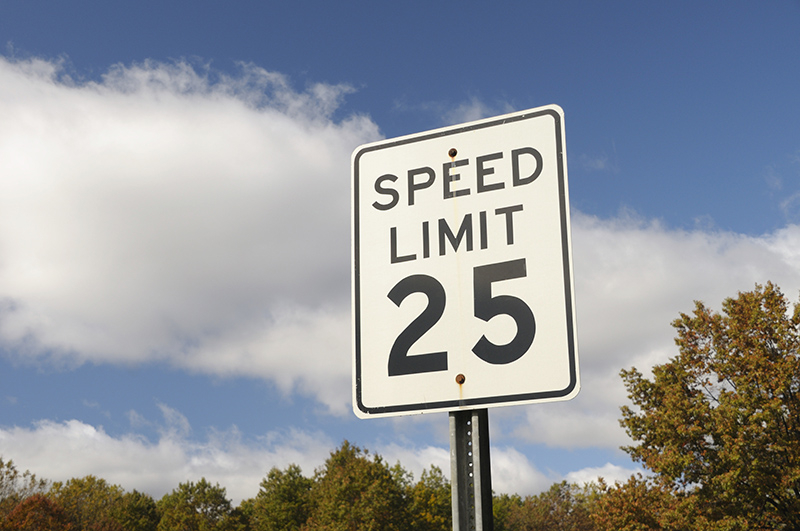
Rules are the guidelines that help all of us know how to act in different situations. Sometimes the rules are clearly stated. They might even be posted in writing:
- Keep your seatbelt fastened at all times on the airplane.
- You must be 18 years old to vote.
- You must drive 25 miles per hour in a residential neighborhood.
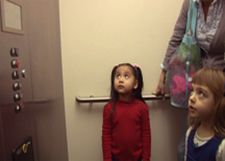
Other times, the rules are not clearly stated or posted. As adults, we have come to know what is expected of us:
- Wait in line quietly at the grocery store checkout.
- Face the front in an elevator.
- Say, “Hi” when someone greets you.
These behaviors are examples of showing respect or being friendly. No one specifically taught us that it is respectful to face the front and give others personal space on an elevator, but we have come to know this.
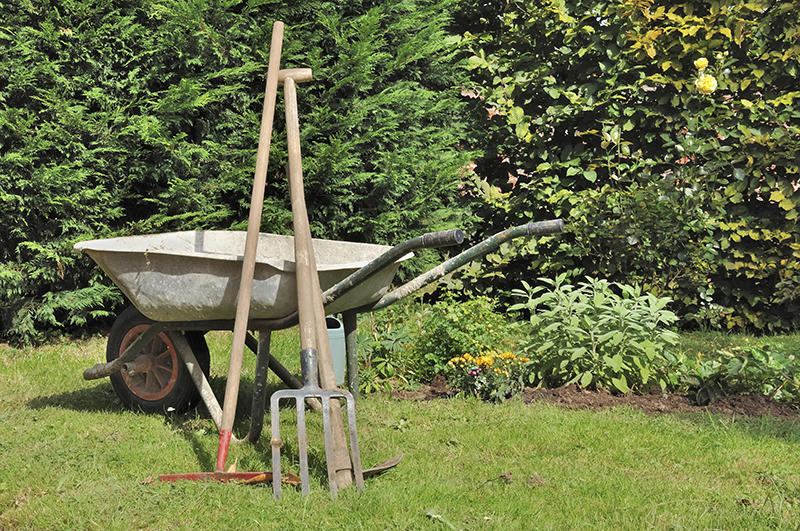
Still other times, we have learned ways of behaving that keep ourselves or others safe. It may not seem like anyone has to tell us to do these things. When you think back to childhood, though, it is likely someone reminded you to walk when carrying hot coffee, carry scissors with the sharp point down, or turn skillet handles in while cooking.
Our parents or caregivers may have taught us these behaviors, or we may have picked up on what others were doing and modeled their behaviors. Young children are just beginning to learn what it means to be in large groups and public places. They are also just beginning to learn that their behavior affects others. Young children live in the here and now; they do not plan their actions or think about consequences the way adults do. It is our job as adults to teach children how to keep themselves and others safe. Teaching children a small number of safety rules is an important part of your job as a family child care provider.
Effective Rules or Expectations
Rules are just one part of a larger plan for keeping children safe. Remember that rules work side-by-side with other parts of good early childhood teaching: a well-designed environment, appropriate learning activities, and nurturing relationships. Rules are guidelines or reminders about what it means to be a member of the family child care community. Effective rules for young children reflect what we know about how young children learn. According to Fox, Jack, & Broyles (2005):
- Rules should be short and clear. Infants, toddlers and preschoolers understand short sentences best. A common example is “Use walking feet.” Can you see how this is easier to understand than a sentence like, “When we are in the house, you should always walk so you stay safe?”
- Rules should be stated positively. Young children have a hard time connecting their behavior to “not to” or “don’t” statements. State rules as what children should do (use gentle touches) rather than what they should not do (don’t hit).
- Rules should be limited in number. Young children can only hold a small number of items in their memory. It is best to teach only three to five essential rules for your family child care setting. If you work mostly with school-age children, you could add a few more, ideally generated by the children themselves.
- Rules should be posted along with pictures. Young children are only beginning to learn that print has meaning. Use pictures or drawings to help children understand what rules mean. This is a great way for children to be active contributors to the rules in your program--they can help find or create pictures that exemplify the different rules.
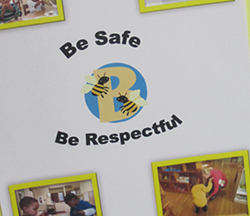
There are two types of guidelines for behavior: expectations and rules. Expectations are general characteristics or ways you would like children to behave. Examples might include:
- Be respectful.
- Be safe.
- Be friendly.
- Respect others.
- Respect the environment.
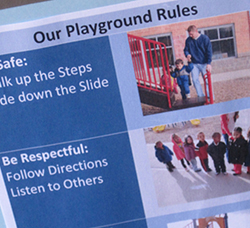
Rules help define exactly what expectations mean. Rules are our way of communicating to children what it means to “be respectful.” Examples of rules are:
- Use walking feet.
- Clean up toys when you finish with them.
- Use gentle hands.
- Follow directions.
As a family child care provider, you can develop expectations, rules, or both. Remember, however, young children are still developing their cognitive skills. It’s important to keep rules and expectations short and simple. Do not be afraid to use complex vocabulary like “respectful.” If you teach what it means to be respectful, children will understand it — and you will have broadened their vocabulary in a positive way!
In your family child care setting, think about developing rules that work for all the children in your care. For example, the rules and expectations listed above can likely apply to all the people in your care setting, children and adults. However, rules like “only use balls outside” may not work if, for example, you have sensory balls for the infants in your program to explore.
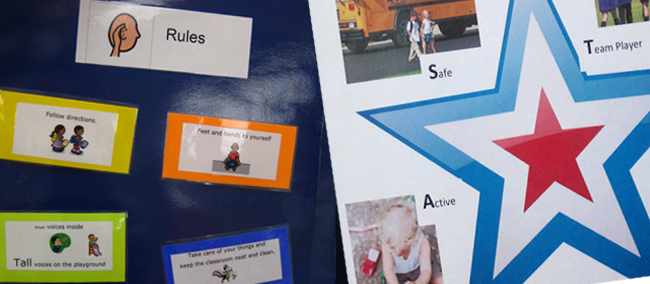
Teaching Rules and Expectations
You have choices in how you design your program rules or expectations: you could write the rules and introduce them to the children, or you can write the rules together with the children.
Regardless of how you decide on your program rules, be sure they meet the guidelines for effective rules described in this lesson. Children sometimes suggest rules that don’t meet the guidelines. For example, children may suggest the rule “Don’t climb the fence on the playground” or “Don’t bite.” You can be prepared for these suggestions and help the children reframe these in positive ways. You could say, “That’s right, we don’t climb the fence. What should we do instead?” You can guide them toward rules like “Keep your feet on the ground” or “Only climb ladders and stairs.” Inviting children to help create the rules for their child care community can be one way of empowering them to be safe in your family child care program. Even as adults we are more likely to remember and follow guidelines when we help create them.
See
Program Rules
Do
Effective Ways to Teach Rules
Model
The first way we help children learn is by being good role models. Our rules should come to life every day in our family child care programs. You can model respect, safety, teamwork, and many other behaviors.
How many times have you seen an adult raise his or her voice to tell children to quiet down? Take a minute to think about the message children receive in that scenario. Make sure your rules apply to both children and adults. Make a point of thinking out loud about the rules. As you clean up a spill on the floor, you might say, “I want to be safe and responsible. I’m going to clean this spill before someone slips.” If there is more than one adult present, everyone can get involved. Practice solving problems together in front of the children. Can you think of other times you can model the rules for children? What about where beverages or food are consumed? Do adults and children follow the same rules?
Post
A well-designed environment prevents safety problems. Your rules should be a part of the environment. Post rules where you are likely to need them: the main play area, by the door to the house, and the eating area. When your rules are posted for children to see, you can refer to them quickly and easily. Children can remind themselves and others of the rules, as well. Post your rules at eye level for the children. Be sure to include pictures or drawings of the rules. You can use clip art, hand drawings, or photos of the children.
If you only care for infants, posting rules is likely not critical, as very young children learn the most about safety from your careful, personal feedback, and may not be able to interpret the pictures or drawings next to printed rules. However, if you have toddlers, preschoolers, or school-agers in your setting, developing and posting rules is one important aspect of safety in your environment. They provide a visual reminder of what rules and expectations are important in your program. You can also invite older children to be models and to provide helpful reminders to younger children who are still learning how to be safe and respectful in their child care community. Older children may become frustrated when younger children take their toys or neglect to put items away, and shout “He is not being respectful!” You can encourage older children to politely share their feelings and fears with the younger children, and help them be a resource about why the rules exist. Explain to the older children where the younger children are in their trajectory of learning, e.g., “When you were younger and learning about respect, you needed lots of reminders too. Part of our job right now is to keep showing our younger friends what it means to be respectful. When we show them our respectful actions and give them kind reminders when they need it, we help them learn.”
Remind and Reinforce
Once you have developed effective rules on your own or with the children in your program, it is important to remember to use them! Posting rules, even with a picture, is not enough. We have to actively teach young children how and when to follow the rules. Here are some ideas for teaching the children how to follow the rules in your family child care home:
- Discussions: Talk about why we have rules. Talk about situations when the rules help us. Ask children to generate examples.
- Act it out: Let children role play the rules. Have them show each other how to be gentle or what walking feet look like. Also remember it can be fun to act out non-examples of the rules (when it can be done safely). If “use inside voices” is one of your rules, let children demonstrate what “outside voices” sound like. This will help them contrast the two volumes.
- Play games: The Center on the Social and Emotional Foundations for Early Learning has several examples of ways providers can help children remember and practice your rules. Watch the Stop/Go video (Video 1.12 in Module 1 at http://csefel.vanderbilt.edu/resources/training_preschool.html) for ideas.
- Remind children of the rules: Refer to the rules when children use challenging behavior. This will help you stay positive with children and redirect them to an appropriate behavior.
- Teach through stories: Read scripted stories about the rules and safety (for example, “I Can Stay Safe” from the Center on the Social and Emotional Foundations for Early Learning; http://csefel.vanderbilt.edu/resources/strategies.html). You can also read other books at group time that help children think about safety, such as Officer Buckle and Gloria by Peggy Rathman. Ask follow-up questions to help children think about safe actions and why they are so important.
Explore
Sometimes we get in the bad habit of telling children what not to do instead of what to do. Review the Reframing the Rules activity. Take a look at the program rules and rewrite them so that they are stated positively.
Apply
Use the Developing Rules activity to reflect on and develop rules for your program. If you already have rules, use it to decide whether they are useful rules for the children in your care. Discuss your responses with your trainer, coach, or family child care administrator.
Glossary
Demonstrate
Fox, L., Jack, S., & Broyles, L. (2005). Program-Wide positive behavior support: Supporting young children’s social-emotional development and addressing challenging behavior. University of South Florida, Louis de la Parte Florida Mental Health Institute.
Hemmeter, M. L. (2009). The Center on the Social and Emotional Foundations for Early Learning. http://csefel.vanderbilt.edu/
OSEP Technical Assistance Center on Positive Behavioral Interventions and Supports. (2019). Positive Behavioral Interventions & Supports. https://www.pbis.org
Rathman, P. (1995). Officer Buckle and Gloria. G.P. Putnam’s Sons.
University of South Florida. (n.d.). National Center for Pyramid Model Innovations. https://challengingbehavior.cbcs.usf.edu/


